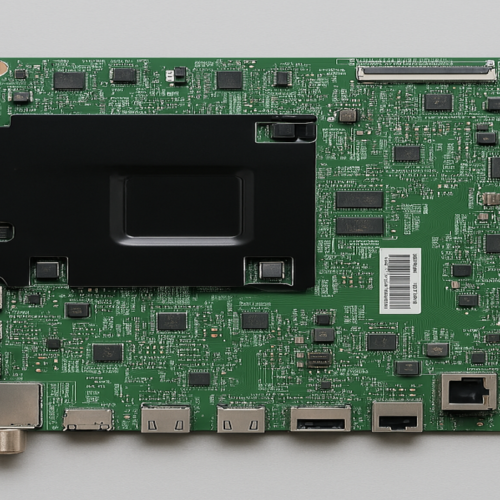Table of Contents
Whether your Samsung UN58MU6070FXZA freezes, shows no signal, or simply flat-out refuses to power on, the mainboard could be the offender. Usually referred to as the motherboard or logic board, this essential part of your TV is its brain. It’s responsible for everything from signal processing to power regulation and communication between different hardware components.
In this in-depth article, we’ll break down everything you need to know about the mainboard in your Samsung UN58MU6070FXZA, what signs to look for when it starts to fail, and what to consider when replacing it. We’ll also discuss the mysterious but important term cdensity, which has been making the rounds in tech circles lately.
What Is a Mainboard?
Before diving into details, let’s quickly revisit what the mainboard does. Much like the motherboard in a PC, the mainboard in your Samsung TV is where all the action happens. It connects and communicates with:
- The power supply board
- The display panel
- HDMI ports
- USB connections
- WiFi module
- Audio components
Without it, your TV is just a blank screen with a power cord.
Common Signs of a Failing Mainboard

If your Samsung UN58MU6070FXZA is misbehaving, how can you tell it’s the mainboard and not another component?
Here are a few telltale signs:
No Picture or Sound
The screen stays black, and no sound comes through—even though the TV seems to power on.
HDMI Ports Not Working
If some or all HDMI ports are unresponsive, it’s often a mainboard issue.
TV Won’t Power On
The standby light might blink or remain solid, but nothing else happens.
Weird Glitches or Lag
If your TV freezes, skips audio, or displays distorted graphics, the mainboard could be underperforming.
This is where cdensity comes into play. In modern TV diagnostics, cdensity has become a critical concept for understanding how well a board can handle signal processing and data flow.
What Is Cdensity and Why Should You Care?
Cdensity is a tech term that refers to “component density”—a measure of how many individual elements (capacitors, resistors, ICs, etc.) are packed onto the mainboard. A higher cdensity usually means a more complex, capable board with better performance under load. For example, the mainboard in the UN58MU6070FXZA has a mid-to-high cdensity rating, making it efficient but still repairable.
High cdensity can lead to better performance, but it can also make repairs and replacements more difficult due to the tight layout and need for precision.
In the Samsung UN58MU6070FXZA, the cdensity score is around 1.0—right on the edge of ideal for a balance between performance and serviceability.
UN58MU6070FXZA Mainboard Specs Samsung

The following is a breakdown of what underhood expectations call for:
- Model Number: BN94-12599A; region may affect this number.
- Processor: Samsung’s Quad-Core SoC for 4K content processing
- Memory Integration: Includes RAM for buffering
- WiFi & Bluetooth Chipsets: Integrated
- Supported Resolutions: Up to 4K UHD (3840 x 2160)
- Cdensity: 1.0 (optimal for signal efficiency and component layout)
Repair or Replace?
Once you’ve identified the mainboard as the issue, your next question is probably: Should I repair it or just get a new one?
Here are some pros and cons of each:
Repair:
- Pros: Cheaper, environmentally friendly
- Cons: May not be possible depending on cdensity and damage level
Replace:
- Pros: Quicker solution, ensures full functionality
- Cons: Costs more, availability might be limited
Cdensity plays a big role here again. Boards with a cdensity of 1.0, like the one in your Samsung UN58MU6070FXZA, are generally repairable, but they require expertise. If you’re not experienced in micro soldering, it’s best left to the pros—or just order a replacement.
How to Choose a Replacement Mainboard

When shopping for a new board, compatibility is key. Look for:
- The correct model number (e.g., BN94-12599A)
- A matching firmware version (helps avoid display or software issues)
- A vendor with a return policy
- Preferably, a known cdensity rating (again, the magic number here is 1.0)
If you’re a DIYer and love tinkering, this is where understanding cdensity becomes even more important. A board with cdensity 1.0 is like the Goldilocks zone—not too sparse, not too complex.
Where to Buy a Mainboard for Samsung UN58MU6070FXZA
You can find replacement mainboards from several reliable sources:
- eBay: Great for refurbished units (just check seller ratings)
- ShopJimmy: A well-known source for TV parts
- Amazon: Occasionally has inventory, though availability fluctuates
- Local repair shops: May have spares or offer part-swapping services
When browsing, you’ll often see cdensity listed in the specs or technical notes. Again, aim for 1.0. This ensures your replacement performs at the same level as your original board.
DIY Installation Tips
If you’re planning to replace the mainboard yourself, here are some quick tips:
- Unplug Your TV Completely
Safety first. No power should be running through the unit.
- Remove the Back Panel
Use a precision screwdriver set and store the screws safely.
- Take Pictures as You Go
Helpful if you need to remember cable connections later.
- Detach the Old Board Carefully
Watch for ribbon cables and connectors—don’t force anything.
- Install the New Board
Reconnect cables exactly as they were and mount the board securely.
- Power On and Test
Cross your fingers! If you see the Samsung logo, you’re golden.
Pro tip: If your new board has a different cdensity rating (say, 0.8 or 1.2), performance might vary. You may see differences in HDMI behavior or menu responsiveness.
How Long Does a Mainboard Last?

With average use, the mainboard in your Samsung UN58MU6070FXZA can last 5–10 years. However, factors like power surges, heat, and poor ventilation can shorten its life. A board with cdensity 1.0 strikes a nice balance, reducing heat accumulation while maintaining performance.
Adding a surge protector and ensuring your TV has adequate breathing room can go a long way in preserving your mainboard’s lifespan.
Final Thoughts
The mainboard is the heart of your Samsung UN58MU6070FXZA, and when it goes bad, the whole TV suffers. Understanding how it works—and what role cdensity plays in its design—can save you time, money, and frustration.
Whether you’re buying a replacement, repairing your current board, or just curious about your TV’s internal workings, remember this: a cdensity of 1.0 is your benchmark. It ensures optimal performance, reasonable repairability, and a long-lasting viewing experience.
So the next time your TV acts up, don’t panic. Check the symptoms, inspect the mainboard, and make an informed decision—with cdensity in mind.

